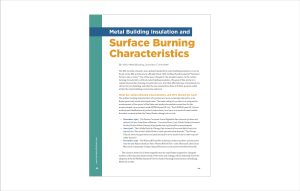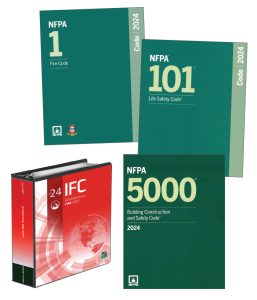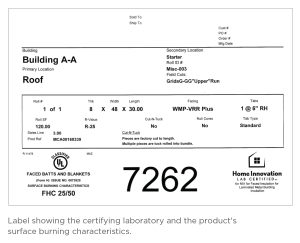Metal Building Insulation and Surface Burning Characteristics
The NIA recently released a new, updated standard for metal building insulation. It can be found on the NIA website and is officially titled, “NIA Certified Faced Insulation® Standard (Version 404.2-2024).” One of the major changes to the standard centers on the surface burning characteristics of faced metal building insulation. The goal of this article is to explain what surface burning characteristics are, how they affect the type of insulation you choose for your building, and what the new standard has done to further promote safety within the metal building construction industry.
What Are Surface Burning Characteristics, and Why Should We Care?
The surface burning characteristics of a product are more commonly referred to as its flame spread and smoke developed index. The index rating of a product is a comparative measurement of the spread of the flame and smoke obscuration versus time for the material tested, in accordance with ASTM E84 and UL 723. The ASTM E84 and UL 723 test method and classification of products came about, over time, as a result of some horrific fires that occurred within the United States, dating back to 1942.
- November 1942 – The Boston Cocoanut Grove Nightclub Fire claimed 492 lives and injured 166 (see Great Fires of Boston – Cocoanut Grove, 1942, Public Guides, Research Guides, Boston Public Library, https://guides.bpl.org/bostonfires/cocoanutgrove)
- June 1946 – The LaSalle Hotel in Chicago Fire claimed 61 lives and left at least 200 injured (see “Fire at the LaSalle Hotel in 1946 exposed safety hazards,” The Chicago Tribune, www.chicagotribune.com/2016/06/05/fire-at-the-lasalle-hotel-in-1946-exposed-safety-hazards)
- December 1946 – The Winecoff Hotel Fire in Atlanta claimed 119 lives and injured at least 90 (see Major American Fires: Winecoff Hotel Fire – 1946, Massasoit Libraries at Massasoit Community College, https://library.massasoit.edu/americanfires/winecoff)
The common theme in all three tragedies was the rapid flame progression along the surfaces of the exposed interior finish of the walls and ceilings, which ultimately led to the adoption of the ASTM E84 Standard Test for Surface Burning Characteristics of Building Materials in 1961.
Although time has passed, the need and awareness still exist today. More than 70 years after the adoption of ASTM E84, another tragedy struck in Rhode Island, in February 2003. A fire erupted and quickly spread during a performance of the metal band, Great White, at the Station nightclub in West Warwick, leaving 100 dead and 230 injured. Once again, one of the primary factors of this tragedy was the rapid flame spread on the surface of the ignited ceilings and walls (see “20 years after the Station nightclub fire, a look at what’s changed,”GBH, www.wgbh.org/news/local/2023-02-21/20-years-after-the-station-nightclub-fire-a-look-at-whats-changed).
What Do the Building Codes Require Regarding Metal Building Insulation and Surface Burning Characteristics?
The International Building Code (IBC) assigns a Surface Burning Characteristic Classification to all building products required to be tested using the ASTM E84 Standard. More specifically, Chapter 8, Interior Finishes, of the 2024 IBC, Section 803.1.2 Interior Wall and Ceiling Finish Materials Tested in Accordance with ASTM E84, are categorized into three classes, as follows:
- Class A = Flame spread index 0–25; smoke developed index 0–450
- Class B = Flame spread index 26–75; smoke developed index 0–450
- Class C = Flame spread index 76–200; smoke developed index 0–450
The following building codes and standards utilize these classes to help determine which products meet code:
- International Building Code (IBC)
- International Mechanical Code (IMC)
- International Fire Code (IFC)
- Uniform Mechanical Code (UMC)
- National Fire Protection Association (NFPA) 1 – Fire Code
- NFPA 101 – Life Safety Code
- NFPA 5000 – Building Construction and Safety Code
- NFPA 90A – Standard for the Installation of Air-Conditioning and Ventilating Systems
The primary reasons to insulate a metal building, besides meeting the codes, are for thermal and acoustic/sound purposes. When determining the materials needed to insulate a metal building, one of the main resources utilized is the ASHRAE 90.1 Energy Standard for Sites and Buildings Except Low-Rise Residential Buildings. Per ASHRAE 90.1–2022, within metal buildings, fiberglass insulation systems can be single layer, double layer, liner system, or filled cavity. In each of these systems, the fiberglass insulation can be either faced (laminated) or unfaced.
When using a faced metal building insulation-whether in the ceiling or walls of metal buildings, or both-in the vast majority of cases, the faced side of the fiberglass insulation is left exposed to the interior of the building.
Section 720.3, Exposed Installation, states, “Insulating materials, where exposed as installed in buildings of any type of construction, shall have a flame spread index of not more than 25 and a smoke-developed index of not more than 450.”
In simple terms, both concealed and exposed faced metal building insulation must be Class A to meet the IBC.
Although not common in practice, there are instances where metal building insulation becomes incorporated into the design of the plenum. In these cases, we would refer to IMC, UMC, and NFPA 90A.
Per the IMC, Section 602.2, Construction of Plenums, states, “Plenum enclosure construction materials that are exposed to the airflow shall comply with the requirements of Section 703.3 of the International Building Code or such materials shall have a flame spread index of not more than 25 and a smoke-developed index of not more than 50 when tested in accordance with ASTM E84 or UL723.”
The UMC and NFPA 90A also state that any insulation materials exposed with a plenum must have a flame spread index of not more than 25 and a smoke-developed index of not more than 50.
Although we have mentioned the more nationally recognized codes and standards, it is important to note that prior to any construction project, it is imperative that all local municipalities’ and state code adoptions be researched and recognized. The best way to do this would be to contact your local authority having jurisdiction (AHJ).
What Does All This Have to Do with the NIA Certified Faced Insulation Standard (Version 404.2–2024)?
In order to comply with the NIA Standard, metal building insulation laminators must subscribe to third-party laboratory verification of surface burning characteristics for their faced metal building insulation products AND have their product packages marked with the label of the certifying laboratory for surface burning characteristics. This allows the building owners, installation contractors, and building code officials and inspectors the ability to easily identify whether the metal building insulation supplied meets the code requirements for surface burning characteristics. It also holds our industry accountable and further advances the reputation and commitment our members have to the safety and well-being of our clients.




